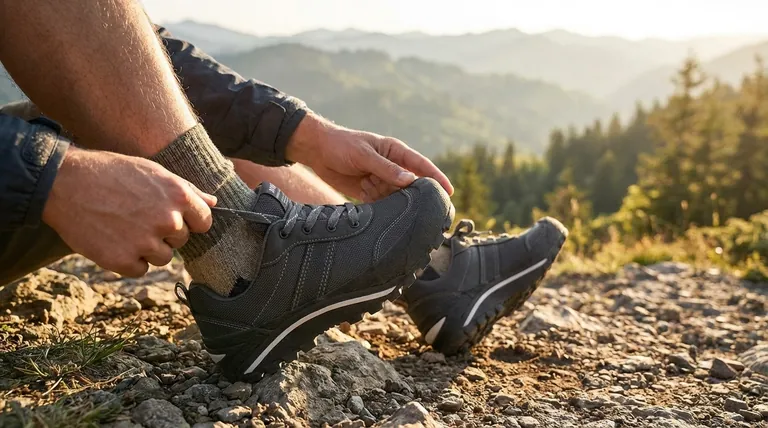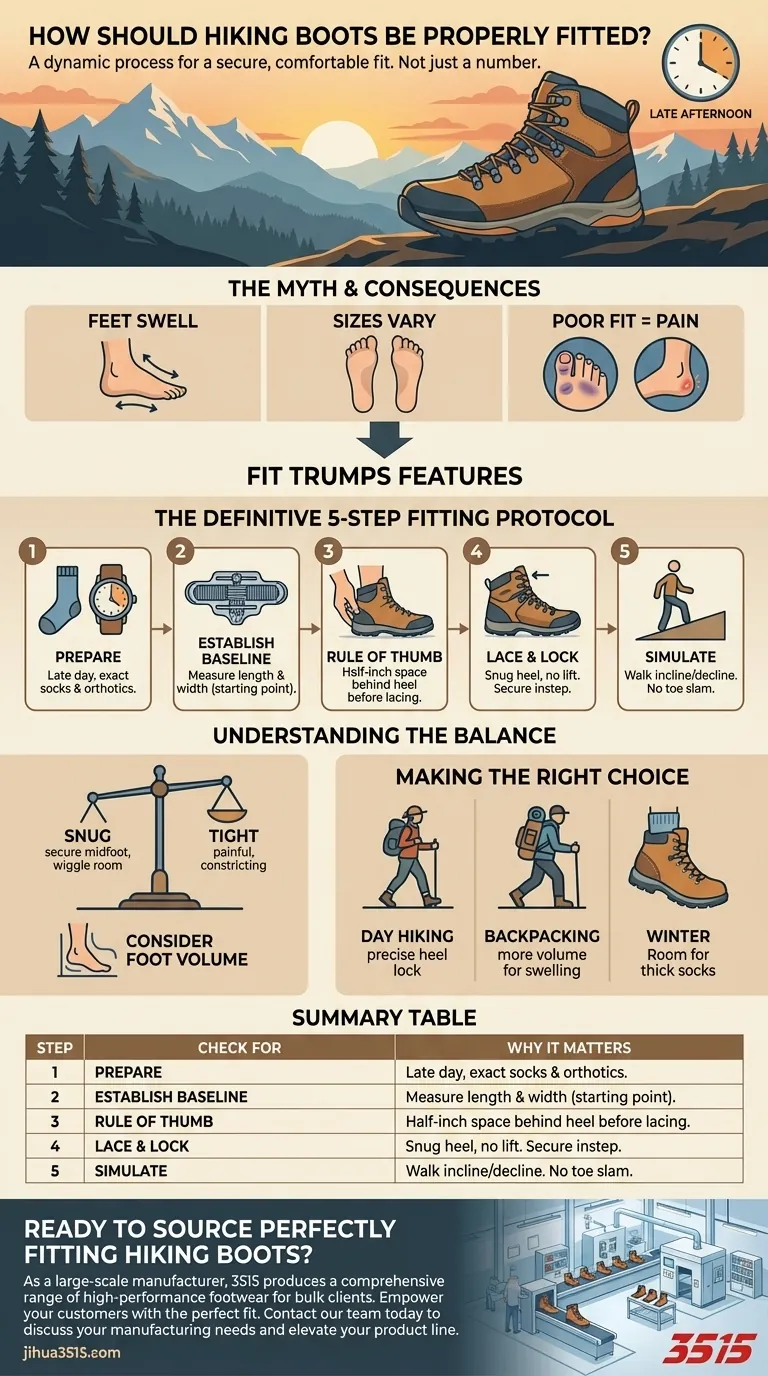Properly fitting a hiking boot is a deliberate process that requires more than just knowing your standard shoe size. You must try boots on late in the day with your intended hiking socks and any orthotics you use. The goal is to lock your heel in place while allowing about a half-inch of space for your toes, a fit you must confirm by walking on an incline.
Your foot size is not a static number; it is a dynamic range. The goal of a proper boot fitting isn't just to match your foot's length at rest, but to accommodate its expansion and movement under the stress of a long hike.

Why a "Good Enough" Fit Fails on the Trail
Understanding the stakes is the first step toward a perfect fit. A minor annoyance in the store can become a trip-ending problem miles from the trailhead.
The Myth of a Single "True" Size
Your feet swell throughout the day and expand even more during a long hike. A boot that feels perfect in the morning can feel constricting and painful by the afternoon.
Furthermore, most people have slight differences between their left and right feet, meaning a single size number is only a starting point.
The Consequences of a Poor Fit
A boot that is too small will cause your toes to jam into the front on descents, leading to bruising and pain. A boot that is too large allows your heel to slip, creating friction that inevitably results in blisters.
Fit Trumps All Other Features
No amount of advanced waterproofing, high-tech materials, or aggressive tread can compensate for a poor fit. The boot's core functions—support, stability, and protection—are all compromised if it doesn't work in harmony with your foot.
The Definitive 5-Step Fitting Protocol
Follow this methodical process to ensure you are testing for how the boot will perform on the trail, not just in the store.
Step 1: Prepare for the Fitting
Go to the store in the late afternoon or evening when your feet are at their largest. Crucially, bring the exact socks and any insoles or orthotics you plan to wear while hiking.
Step 2: Establish Your Baseline Measurement
Ask to have your feet measured with a Brannock device. This provides an accurate length and width measurement that serves as your starting point, but it is not the final word on your size.
Step 3: Perform the "Rule of Thumb" Check
Put the boot on, but before lacing it up, slide your foot forward until your toes touch the front. You should be able to comfortably slide one index finger (about a half-inch) into the space behind your heel.
Step 4: Lace Up and Lock Down Your Heel
Lace the boots snugly, focusing on securing your instep and ankle. Your heel should feel locked into the back of the boot. When you walk, your heel should not lift up more than a tiny fraction of an inch.
Step 5: Simulate Trail Conditions
Walk around the store for several minutes. Most reputable outdoor stores have a small ramp or set of stairs for this purpose.
Walk up the incline to ensure your heel stays put. More importantly, walk down the incline to verify that your toes do not slam into the front of the boot.
Understanding the Trade-offs and Pitfalls
Achieving the right fit involves balancing competing needs and avoiding common mistakes.
Too Big vs. Too Small
Hikers often buy boots too small, fearing instability. However, the pain from jammed toes on a descent is a far more common problem. It's generally better to have slightly too much room in the toe box than not enough.
Confusing "Snug" with "Tight"
A proper fit should be snug, not tight. Your midfoot and heel should be held securely to prevent movement, but your toes need enough room to wiggle and splay out naturally.
Ignoring Your Foot's Volume
Fit isn't just about length. Some boots are designed for high-volume (thicker) feet, while others are for low-volume (slimmer) feet. If a boot feels too tight over the top of your instep, you may need a different model, not just a different size.
Making the Right Choice for Your Hike
Your ideal fit should be tailored to your specific hiking objectives.
- If your primary focus is day hiking on established trails: Prioritize a precise heel lock to prevent blisters, ensuring you still have adequate toe room for descents.
- If your primary focus is multi-day backpacking: Err on the side of slightly more volume to accommodate significant foot swelling caused by carrying a heavy pack over many days.
- If your primary focus is winter hiking: Ensure you have enough room to wear thick thermal socks without compressing their insulation, as this pressure can restrict blood flow and lead to colder feet.
A well-fitted boot becomes an extension of your body, empowering you to focus on the experience ahead, not the pain in your feet.
Summary Table:
| Key Fitting Step | What to Check For | Why It Matters |
|---|---|---|
| Prepare for Fitting | Wear intended socks; go in the late afternoon. | Feet are largest then, ensuring a true fit. |
| "Rule of Thumb" Check | A half-inch of space behind your heel. | Prevents toes from jamming on descents. |
| Lock Down Your Heel | Heel should not lift when walking. | Eliminates friction to prevent blisters. |
| Simulate Trail Conditions | Walk on an incline/decline in the store. | Tests boot performance under real hiking stress. |
Ready to source perfectly fitting hiking boots for your customers?
As a large-scale manufacturer, 3515 produces a comprehensive range of high-performance footwear for distributors, brand owners, and bulk clients. Our production capabilities encompass all types of hiking boots and shoes, engineered for superior support, stability, and comfort right out of the box.
We can help you provide your customers with the perfect fit that empowers their adventures.
Contact our team today to discuss your manufacturing needs and elevate your product line.
Visual Guide

Related Products
- Durable Rubber Sole Outdoor Shoes Wholesale & Custom Manufacturing
- Safety Footwear Wholesale Manufacturer for Custom OEM/ODM Production
- Durable Waterproof Rain Boots | Custom Manufacturer for Wholesale & Brands
- Premium Wholesale Waterproof Safety Boots High Performance Protection for Industrial Markets
- Wholesale Safety Footwear Manufacturer for Bulk & Custom OEM Orders
People Also Ask
- Why are vulcanized soles popular in urban fashion? Discover the Legacy of Authentic Street Style
- What are some alternatives to hunting boots? Hiking, Rubber & Tactical Boots Explained
- What were traditional shoe soles made from before rubber? The History of Leather Soles
- What should be considered when choosing hiking boots for snake protection? Prioritize Fit & Materials for Safety
- What are the main applications of vulcanized rubber? Unlock Durability for Tires, Footwear & More



















